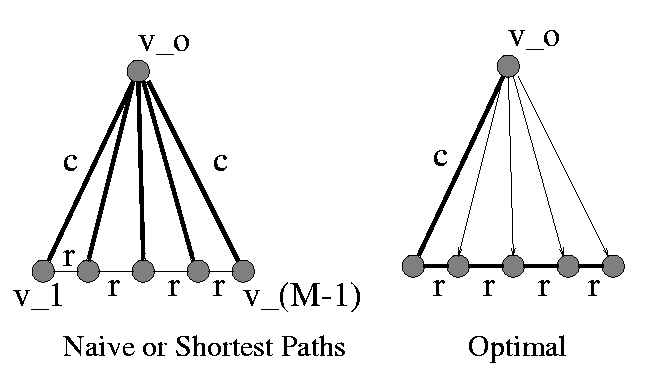
The problem is NP-complete, which means that there is no known
*polynomial* algorithm
that will find the exact solution of the problem. However, there are algorithms
that solve the Steiner problem in exponential time (O(2^N) or O(2^M)).
Dynamic programming. Decompose graph in two parts, solve the problem
for each part and then combine the solutions.
The Naive or Shortest Paths algorithm.
Find the Shortest path tree from one participant node to the rest of
the graph.
Prune the parts of the tree that do not lead to a participant.
Complexity O(N^2), CR = O(M).
The Greedy or Nearest Participant First algorithm.
Start from a participant.
Find the participant that is closest to the current tree.
Join the closest participant to the closest part of the tree.
Repeat until you have connected all nodes.
Complexity O(M N^2), CR = O(1), actually CR <= 2.
The Rayward-Smith algorithm. (Not presented in class)
The Kou Markowsky and Berman algorithm (KMB).
1. Find the complete distance graph G'
(G' has V' = S , and for each
(u,v) in VxV there is an edge with
weight equal to the weight of the min-cost path p_(u,v) in G)
2. Find a minimum spanning tree T' in G'
3. Translate T' to the G graph, by substituting every edge of
T'
with the corresponding path of G. Let us call T the result of the translation.
4. Remove any possible cycles from T.
Complexity O(M N^2), CR = O(1), actually CR <= 2.
CR_naive <= M-1
Proof: Let d_max be the maximum distance between any two participants.
The optimal tree Topt will be at least as large i.e.
Topt => d_max
(1)
The Naive tree Tnaive will never be more expensive than:
Tnaive <= (M-1) d_max
(2)
This is easy to prove. Select a root among the participants
and find all
the shortest paths p_i between the root and every other of the i= 1,...M-1
participants.
The cost of of the path of each path p_i is less than d_max,
and the total cost of
the Tnaive is the union of these paths, which proves (2).
Now, we write (1) as:
1/ Topt <= 1/d-max
(3)
If we multiply (2) and (3), we get:
Tnaive / Topt <= M-1
Q.E.D.
Lemma 2.
There exists a graph G(V,E) and a set of participants S, M=|S|,
such that the ratio of the Naive for the Steiner problem is:
Tnaive /Topt = M-1
Proof. I only need to show one instance of the Steiner problem
that this
happens. Assume a graph that has a node v_o that connects to
every other
node in the graph v_1 to v_(M-1), and the cost of the edge:
w(v_o, v_i) = c
Assume that every node v_1, v_2, .......v_(M-1) connects
with the previous and the next in this order and v_1 connects with
v_(M-1).
The cost of these edges is r, and is infinisimal (really small or r
-> 0).
Assume that all nodes are participants.
A possible execution of Naive is to pick v_o as root and connect
every other
node with the direct edge of cost c.
Tnaive
= (M-1) * c
(1)
The optimal tree connects v_o and v_1 and then everybody
else with
edges of cost r.
Topt = c + (M-2) * r
=>
Topt = c, for r -> 0
(2)
Using (1) and (2):
Tnaive /Topt = M-1
